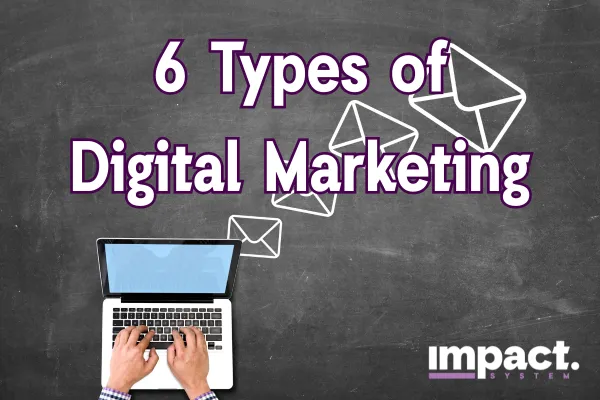
The 6 Digital Marketing Strategies Every Business Owner Should Know
What are the types of digital marketing?
If you’re trying to grow your business online, you’ve probably been told to start with social media. You might’ve even spent hours designing Canva graphics, posting quotes on Instagram, or experimenting with TikTok dances—only to see little to no results.
Here’s the truth: social media isn’t the best starting point.
After working with hundreds of entrepreneurs inside the Impact System, the biggest mistake I see over and over is starting in the wrong place. Digital marketing is powerful—but only if you know where to begin.
In this post, we’re breaking down the 6 essential types of digital marketing, how each one works, and which strategy to start with if you want results faster.
Let’s dive in.
Looking for a video? Check out our full video on the topic here:
1. Social Media Marketing
Most business owners assume this is step one. But it’s not.
Social media marketing includes:
Posting content on platforms like Instagram, Facebook, LinkedIn, and TikTok
Collaborating with influencers or content creators
Direct outreach via DMs
Building online communities
Attempting to go viral with trends and short-form videos
The main challenge? Noise and competition. Every business is vying for attention, and organic growth on social platforms can be painfully slow without an existing audience or paid support. Plus, trends shift quickly, and what works one week might flop the next. You don’t control the platform—you’re building on rented land.
Social algorithms also reward engagement, not necessarily value. So unless your audience is already tuned in and interacting with your posts, your visibility remains low. This is why many business owners feel stuck posting daily with little return.
Effective social media strategy requires:
Consistency in posting and engaging with your community
A strong, recognizable brand voice and visuals
Clear calls to action
Strategic use of stories, reels, and live content to improve reach
A plan to repurpose content across multiple platforms
It also works best when paired with other strategies—like email marketing or content marketing—that drive traffic and help convert followers into leads.
When social works best:
You already have an engaged audience
You have a clear brand voice and content strategy
You’re ready to amplify offers or stay top of mind
You're using it as a retargeting tool in your ad strategy
When to delay it:
If you don’t yet know who your ideal client is
If your offer isn’t validated
If you’re just starting your business and need faster ROI from other channels
If you’re just starting out, skip this as your first step. Focus on building leverage and assets (like content, SEO, and a list) that will keep working for you in the background.
2. Search Engine Optimization (SEO)
SEO is your secret weapon—especially if you're a service provider, local business, or coach.
Search Engine Optimization means:
Optimizing your website and blog (on-page SEO)
Building backlinks and authority (off-page SEO)
SEO helps you show up exactly when your ideal customer is searching for what you offer. Think:
“Best family lawyer in Austin”
“How to choose the right marketing software”
While others are fighting the algorithm for attention, SEO lets you attract high-intent traffic passively.
Invest in SEO early and you’ll thank yourself in 6 months.
3. Pay-Per-Click Advertising (PPC)
If you have any budget at all, start testing with PPC. It’s fast, measurable, and scalable.
PPC includes:
Google Ads
YouTube Ads
Facebook & Instagram Ads
TikTok Ads
Why it works:
You can start small (as little as $10–$20/day)
You get results quickly—often same day
You collect real data on your message, audience, and offer
PPC is not just about running ads. It’s about running experiments that teach you what works—fast.
4. Mobile Marketing
This is the most overlooked strategy, and it's costing businesses big.
Ask yourself:
Is your site easy to read on a phone?
Are your buttons tappable?
Does your message land within 3 seconds on a 6-inch screen?
96% of your audience is on mobile, yet most businesses still design for desktop.
Mobile marketing also includes:
SMS marketing
Push notifications
These channels get opened and seen—if you use them well. It’s not about spamming; it’s about timing, trust, and relevance.
Pro tip: Audit your entire sales flow from your phone. You’ll uncover fixes that immediately boost conversions.
5. Content Marketing (Start Here)
If you’re starting from scratch, this is where to begin.
Content marketing is:
YouTube videos
Podcast episodes
Blog posts
Newsletters
Lead magnets (free downloads or guides)
Your content is digital real estate—assets that work for you long-term. Think of it like compounding interest. You don’t build wealth overnight, but the growth becomes exponential if you stay consistent.
Most people quit too early. The ones who win? They show up, even when no one’s watching.
Create value. Publish with purpose. And build trust before you sell.
6. Email Marketing
Email might not seem flashy, but it’s still the highest-ROI channel in digital marketing.
Why?
Emails feel personal
They go directly to your audience
They allow for nurturing and storytelling
But most businesses misuse it:
No segmentation
No automation
Only email when they want to sell
When used right, email builds relationships, delivers value, and sells naturally.
Start building your list now—even if it's from scratch.
7. Affiliate & Influencer Marketing (Bonus)
While not always the first move, affiliate and influencer marketing can amplify what’s already working.
Affiliates promote your offers in exchange for a commission
Influencers introduce your brand to new, engaged audiences
These work best after you’ve validated your product, message, and offer.
So… Where Do You Start?
Here’s your simplified roadmap:
Start with content marketing – Build value and trust
Add SEO and email marketing – Attract and nurture leads
Use PPC to test & scale – Learn fast, iterate faster
Optimize for mobile – Capture conversions
Leverage social later – When you already have attention